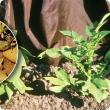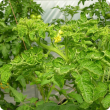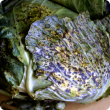Crops
The Department of Primary Industries and Regional Development continues to support the growth and international competitiveness of all crop industries in Western Australia.
With a 2400 kilometre span from its tropical north to its temperate south, WA supports a broad range of cropping industries from rain-fed winter cereals through to irrigated horticultural crops.
In the 2012/13 year the WA cropping industries exported a total of $3.9 billion which comprised: $3.1 billion of cereals, $859 million of pulses, pastures and oilseeds, $142 million of horticultural crops. The major contributors to these exports were wheat ($2.7 billion), canola ($756 million), barley ($377 million), lupins ($42 million), carrots at $48 million, oats ($12 million), and strawberries at $5.5 million.
Articles
Filter by search
Filter by topic
- (-) Remove Vegetables filter Vegetables
- Horticulture (7) Apply Horticulture filter
- Pests, weeds & diseases (7) Apply Pests, weeds & diseases filter
- Diseases (7) Apply Diseases filter
- (-) Remove Viruses & virus-like filter Viruses & virus-like
- Potatoes (3) Apply Potatoes filter
- Tomatoes (3) Apply Tomatoes filter
- Biosecurity & quarantine (3) Apply Biosecurity & quarantine filter
- Biosecurity (3) Apply Biosecurity filter
- Plant biosecurity (3) Apply Plant biosecurity filter
- Capsicums and chillies (2) Apply Capsicums and chillies filter
- Cauliflower (1) Apply Cauliflower filter
- Chinese cabbage (1) Apply Chinese cabbage filter
- Grains (1) Apply Grains filter
- Nursery & cutflowers (1) Apply Nursery & cutflowers filter
- Carrots (1) Apply Carrots filter
- Canola (1) Apply Canola filter
- Broccoli (1) Apply Broccoli filter
- Brussels sprouts (1) Apply Brussels sprouts filter
- Cabbage (1) Apply Cabbage filter
- Beans (1) Apply Beans filter










